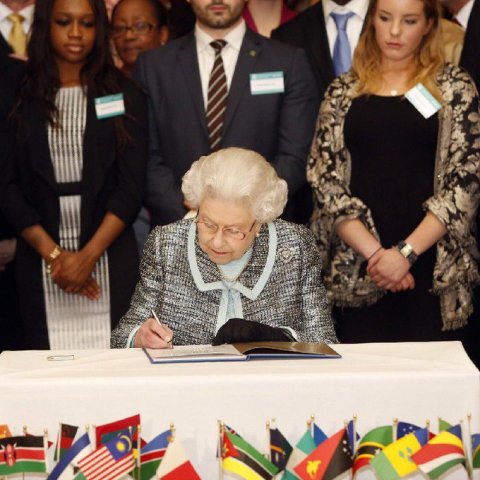 The Queen signs the Commonwealth Charter in 2013. [photo: Commonwealth Secretariat archves]
The Queen signs the Commonwealth Charter in 2013. [photo: Commonwealth Secretariat archves]
[This is an excerpt from an article in The Round Table: The Commonwealth Journal of International Affairs.]
Abstract
In this article the author, a former senior official of the United Nations and Commonwealth Secretariat, offers his personal reflections on one of the most important developments in the history of the Commonwealth, namely, the establishment of the Eminent Persons Group (EPG) in 2009 and the evolution of the Commonwealth Charter. The article throws light on many of the behind-the-scenes activities and exchanges which preceded the publication of the EPG’s report in 2011.
Scope for expansion
Having been involved in the drafting and negotiation process for numerous Ministerial Communiques at the OECD and the Commonwealth, I knew that texts always expand during the negotiation process. Therefore, it was imperative to ensure the first draft was as concise as possible. Any proposals to include principles for which there was no existing basis were rejected. This led to an especially difficult exchange with one High Commission that was insisting that the principle of religious tolerance be included in the Secretariat draft. Although such an inclusion would be substantively non-contentious (and indeed it was later added to the draft Charter by consensus), I rejected the request: the Secretariat draft had to comply strictly within the mandate to including only values already agreed elsewhere. But I was made to feel very uncomfortable – I received calls from that Government over the Easter break just a week or so before the meeting, saying that this had been referred to their Prime Minister. I was told bluntly that the Secretariat was considered unhelpful and intransigent and that this could have consequences.
The Australian Government was extremely supportive throughout all the preparations for the Senior Officials’ Meeting. With respect to the Charter, they supported the approach we recommended. They also supported my firm stance on the religious freedom issue.
Find out more about the Round Table, Britain’s first international affairs journal, founded in 1910
At the beginning of the Senior Officials’ Meeting, Members overwhelmingly agreed the Secretariat draft as the basis for discussion. And the process all the way through to Heads went surprisingly smoothly, given the earlier misgivings about creating a Charter. Huge credit for this goes to the Australian Chair of the Senior Officials Meeting and Foreign Minister Carr who chaired the Ministerial Task Force. They ran their respective meetings smoothly, efficiently and effectively. For transparency, we circulated to all Members the comments and suggestions that had been received, whether through national consultations, or by the Secretariat itself, to ensure that these would remain at the forefront of negotiators’ minds as we developed the Charter of the Commonwealth. And, indeed, many delegates made direct reference to these inputs during the discussions among Officials and then Ministers. A few sections were added during the inter-governmental process, including a preamble, but the text didn’t change hugely from the draft we submitted for the Senior Officials Meeting. The Chairs of both the Senior Officials and Ministerial Task Force asked me to ‘hold the pen’ and make all the drafting changes throughout the negotiation process. When making changes to the negotiating draft, we were assiduous in showing sources for all the language used (it was still important to assure Members that, except in a few areas where there was consensus to introduce new concepts or language, the text was indeed derived from previous declarations approved at different CHOGMs). At the same time, recognising that the Charter should constitute a useful tool for spreading understanding of the Commonwealth and what it stands for, across communities and especially young people, I strove to ensure the language remained as accessible and least bureaucratic as possible. Despite one hiccup towards the end of the process, as one Member required an extension for the completion of its internal administrative processes, the final draft, as recommended by Foreign Ministers at their September meeting was approved, through written procedure, by all Heads of the Commonwealth on 14 December 2012. The Queen duly signed the Charter on the evening of Commonwealth Day, 2013.
The Charter certainly has its flaws. Sadly, though unsurprisingly, very few Governments undertook any serious attempts to garner through a broad participatory process the voices of civil society or their citizens. And the Secretariat’s own efforts at public consultation were necessarily circumscribed and prompted modest feedback and few suggestions. It is perhaps ironic therefore, that Governments from across the Commonwealth, regardless of whether they were democratically elected through fair and free elections or made any attempt to gather views from their citizens, had no qualms in deciding that the Charter should begin with the words ‘We The People of the Commonwealth’ (which had been proposed in the draft appended to the EPG Report) instead of the more modest ‘On behalf of the Peoples of the Commonwealth’ as proposed in the Secretariat’s draft.
Finding future solutions for a modern Commonwealth – enforcing values and human rights
Nevertheless, whatever its shortcomings, I believe that the Charter has huge potential value. Even with little new content, the agreed Commonwealth values embodied in the Charter comprise the minimum standards that should be expected of Commonwealth Member Governments (and, indeed, that they should expect of themselves). However, it does seem to have become something of a ‘dead letter’, as abuses of its enshrined principles continue to go unaddressed. If it is going to mean anything in the future, much more needs to be done to promote awareness of the Charter, and to demonstrate its value.
Steve Cutts is a Member of the Oversight Advisory Committee, United Nations Population Fund, New York, USA.



